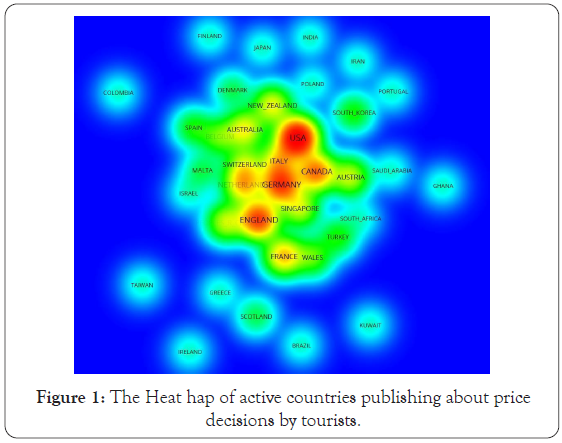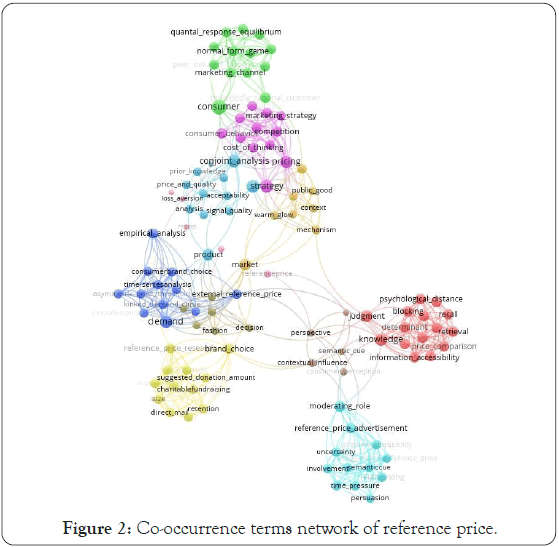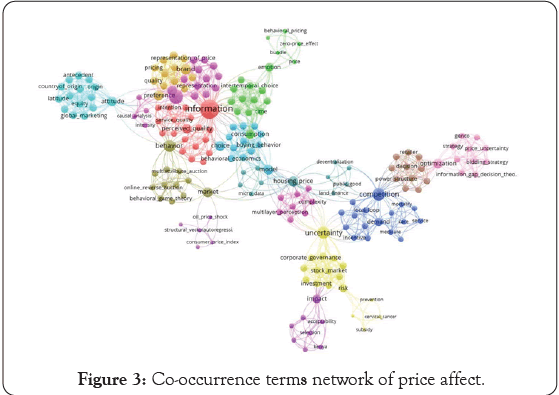Journal of Tourism & Hospitality
Open Access
ISSN: 2167-0269
ISSN: 2167-0269
Mini Review - (2021)Volume 10, Issue 1
Background: Tourists are influenced by pricing effects when deciding to buy a specific product. As this research field continues to evolve, this study reviewed the tourist’s process of price information and tourists’ behavior of related literature, focusing on the analysis of general price decisions theory and highlighting its empirical study with information processing. This study aims to review tourist literatures on price processes and behavior, and identify research term networks and active research countries based on previous literature.
Method: The articles found in the ISI Web of Science database were reviewed using bibliometric analysis, focusing on the literatures on price decisions about tourists published in the top 20 marketing journals. We analyzed the bibliographic data through a quantitative analysis approach and a knowledge mapping technique using bibliometric data. Knowledge mapping was performed using VOS viewer (V1.6.6), focalizing on “link strength” of networks based on author keywords, and the text corpus (title and abstract). To identify emerging terms, we manually edited the thesaurus list to exclude the general terms such as tourist, market and category and to avoid irrelevant terms (i.e., pricing strategy, price competition, industry or BOB pricing). We used the full counting method to produce co-occurrence networks of the most-used terms for author and corpus text keyword with a minimum of 2 occurrences for each term, and make the heat hap of active countries publishing about price decisions by tourists.
Conclusion: It was found that USA and Germany are leading price decision research about tourists, and Current research focuses on tourists' response to a single price information and ignoring price affect during tourists’ decisions, which is assumed to be in a non-updated and certain information state. Therefore, it is encouraged that the growing community of researchers reveal the dynamical tourist’s price decisions under uncertain with a dual system (cognitive and affect) in the future.
Price decisions; Information processing; Bibliometric analysis
For the modern tourism market, many innovative pricing mechanisms have evolved, and changes have occurred in the relationships among consumers, prices, and retailers. For example, new participatory pricing mechanisms, such as Pay What You Want (PWYW), Name Your Own Price (NYOP), and probabilistic selling, have been recently applied. In the market, Businesses transform the uncertainty of demand into the uncertainty of tourists purchasing information [1,2], and consumers are confronted with decisions under uncertainty.
With the emergence of new market concepts, new theories and new market phenomena are gradually being updated, such as paying attention to the emotional process of price that has been widely ignored in price research. Unfortunately, the traditional price theories cannot fully explain the consumer’s price decisions. Traditional (microeconomic) price theory argues that consumers will rationally allocate their budgets at a given price and income, make choices based on their preferences and achieve the goal of maximizing utility [3]. More recently, some studies have also stated that ignoring or simplifying information-based decisions cannot be considered optimal [4,5].
Given this limitation, it would be useful for researchers in this field to be aware of trends in tourists’ price decisions. Hence, in this bibliometric analysis and mini-review, we aimed to develop a framework to classify the advances that have been made in the research of tourists’ price decision in the past decade. To this end, we systematically analyze the dynamic developments of the literature and identify the key conceptual and theoretical advances. We hope that our work will serve as a roadmap to allow the identification of key knowledge gaps and research priorities.
USA and Germany leading price decision research about tourists
Figure 1 shows the most active countries publishing about price decisions by tourists (the darker the color indicates the more active the country) are USA, Germany, England, Canada, other countries of North American and Western European. Researchers from Australia and other Oceanian countries have recently cooperated and published some articles. There are relatively few studies on price decisions about tourists in Eastern countries, but Korean researchers have begun to pay attention to the issue of behavioral prices. The researchers in Singapore have close cooperation with them in the England and Germany [6].

Figure 1: The Heat hap of active countries publishing about price decisions by tourists.
Price decisions by tourist
Price cognition with information processing: The price theory most recognized by the academic community is reference price theory. Significant literature supports the view that consumer decisions and choices are based on a comparison of the observed price and an internal reference price [7]. Measuring transaction utility depends on a comparison between the actual price and the reference price [8].When the internal reference price is higher than the observed price, the perceived value of the product is positive (gain). The reverse is also true: when the observed price is higher than the reference price, the perceived value is negative (loss) [9]. Therefore, reference price theory holds that consumers compare the price of a targeted commodity with its internal reference price [10], thus allowing the consumer to determine whether the targeted commodity price is attractive. If the actual price of the targeted commodity is lower than the reference price, the targeted commodity price is considered more attractive.
The co-occurrence terms network of reference price research are shown in Figure 2. According to key words, the most concerned areas in reference price are the formation of reference prices and the impact of asymmetric reference prices. The terms internal reference price, external reference price, and perception are usually used to study the formation of reference prices [11]; terms such as brand selection, panel data, selection model, loss aversion, and judgment are active in asymmetric reference price effects and loss aversion [12].

Figure 2: Co-occurrence terms network of reference price.
Prices are important for the economy of the tourism industry. It is difficult for consumers to perceive the quality of a pre-trip synchronized (production and consumption occur simultaneously), heterogeneous, perishable and intangible tourism product. Therefore, consumers can perceive product quality only by using price [13]. High uncertainty about tourism products and heuristic judgements by consumers significantly impact purchasing preferences. For example, a person is willing to pay a higher price to achieve a sense of security and to ensure future gains [14]. However, people often measure a product’s value not only by the actual price but also by the perceived reference price [15]. Furthermore, consumers estimate the ability of a product or service provider using the company’s or product’s image rather than the quality of the product itself [16]. Tourism is a typical experiential product that leads to strong information asymmetry between tourists and providers. To reduce this uncertainty, tourists rely on price to make decisions.
After receiving price information, potential tourists encode and interpret it, assigning the product a perceived price [16]. Even when the external information is the same, potential tourists may produce different reference prices that reflect their existing beliefs. This received information is used to evaluate subsequent price information to update the reference price. Studying reference prices helps clarify how potential tourists react to actual prices and helps determine whether advertising affects price. However, there is scant literature on reference prices in tourism, and any research that does exist focuses on a specific location. Oh [17] estimated the reference and average market prices of a specific hotel but did not study price perception asymmetry at the individual level. Kim [18] measured sample visitors’ perceptions of the management fees at a Texas state park using a Likert-type scale (very low, low, reasonable, high and very high). The authors conducted a regression analysis on behavioral and economic factors to determine which factors have stronger explanatory power but did not assess the dynamic effects of external information on the reference price.
Price affect under uncertainty: “Price affect” refers to the emotions, feelings and moods associated with prices [18]. Price affect can be broadly defined as the psychological state caused by the cognitive evaluation of price stimuli [18]. As shown in Figure 3, the main key terms of price affect include information, emotion, competition, uncertainty, attitude, behavior and optimization. Whether different types of price information will cause emotional reactions among tourists, regarding the absolute price level, researches have always shown that higher prices induce more negative emotions and reduce positive emotions [19,20], thus confirming the preliminary exploratory research results of O'Neill and Lambert [21]. Uncertainty affects people’s price decision behavior more or less [22,23]. Information uncertainty increases the state of fear and anxiety, and increases amygdala activity in both human and non-human primates in more complex situations, such as during gambling tasks in which the likelihood of a specific outcome changes, amygdala activity also increases with the degree of uncertainty [24].

Figure 3: Co-occurrence terms network of price affect.
At present, some studies have considered the tourist affect caused by the price level (high and low) into their price decisionmaking research, most of which are based on the assumption that consumers have perfect information [25], but ignore the tourist affect caused by the combination of uncertain product information and price under the new pricing mechanism. The pricing of uncertainty is also one of the contents of future research, because the emotion caused by uncertainty often plays an influential role in the processing of price information and the response to price information [26-30].
Bibliometric analysis and visualized mapping can help monitor research trends focused in price decisions by tourist under uncertainty. In addition, forming a reference point is a complex psychological process that depends on specific decision-making situations, which has both cognitive and emotional components, and future studies need to further analyze the tourist price decisions under the dual system from an empirical perspective. This information was essential for the marketing policy makers to deliver and update the price information to enhance the attractiveness of the tourism product, supporting consumers in making a final decision. The trends in price decisions by tourist are now moving towards the study of revealing the dynamical price information processing under uncertain with a dual‐ system(cognitive and affect).
Citation: Song H (2021) Recent Trends of Pricing Decisions by Tourists: A Mini Review. J Tourism Hospit. 10:456
Received: 11-Jan-2021 Accepted: 13-Jan-2021 Published: 20-Jan-2021 , DOI: 10.35248/2167-0269.21.10.456
Copyright: © 2021 Song H. This is an open-access article distributed under the terms of the Creative Commons Attribution License, which permits unrestricted use, distribution, and reproduction in any medium, provided the original author and source are credited.